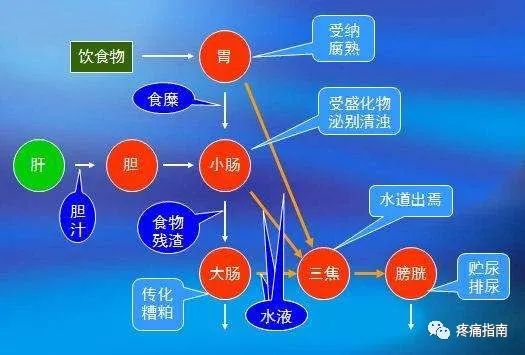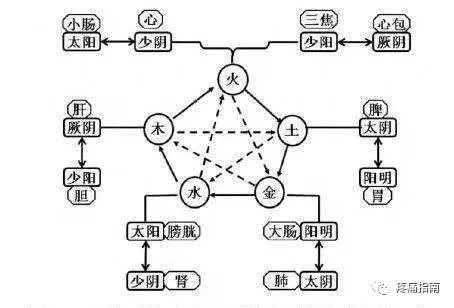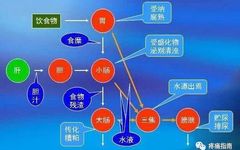
Click↑ Follow us in blue!
II. The Relationship Between the Six Fu Organs
The physiological functions of the six Fu organs—gallbladder (Dan), stomach (Wei), large intestine (Da Chang), small intestine (Xiao Chang), bladder (Pang Guang), and San Jiao—are different, yet they all serve as organs for the transformation of food and the movement of fluids. The processes of digestion and absorption of food, distribution of fluids, and excretion of waste are all accomplished through the cooperation and coordination of the six Fu organs.
The stomach, gallbladder, and small intestine work closely together to digest and absorb food, passing the waste to the large intestine, which then reabsorbs and expels the waste from the body. The bladder’s function of storing and expelling urine is also interconnected with the San Jiao’s role in fluid transformation. The functions of the San Jiao include its involvement in digestion, absorption, and excretion.
The six Fu organs must coordinate with each other to maintain their normal physiological state of being “full but not overfilled,” allowing for the proper movement of substances in and out. Since the six Fu organs are responsible for the transformation of food and fluids, they must continuously receive and expel, alternating between fullness and emptiness, hence the saying “the six Fu organs function through communication.”
Why is it said that “the six Fu organs function through communication”? Because once food is ingested, it undergoes a series of transformations through the collective action of the six Fu organs, from digestion and absorption to the excretion of waste, which must occur continuously and sequentially from top to bottom. The contents of the six Fu organs cannot remain stagnant; thus, “the six Fu organs function through communication” or “the six Fu organs function through smoothness.”

Pathologically, the six Fu organs influence each other. For example, if the stomach has excess heat, it can scorch fluids, leading to dry stools and impaired large intestine function. Conversely, if the large intestine’s function is disrupted, it can cause constipation, which may lead to disharmony in the stomach, resulting in symptoms such as belching and nausea. Similarly, if gallbladder fire is excessive, it can affect the stomach, leading to symptoms like vomiting bitter bile, indicating disharmony in the stomach. Additionally, if there is damp-heat in the spleen and stomach, it can steam up to the gallbladder, causing symptoms like bitterness in the mouth and jaundice.
In treating diseases of the six Fu organs, TCM states that “Fu diseases are treated by promoting communication” and “all six Fu organs should be treated by promoting smoothness.” This is because diseases of the six Fu organs often manifest as impaired communication and transformation. If treatment restores the smooth function of the six Fu organs, their functions will return to normal, hence the saying, “Fu diseases are treated by promoting communication.” Here, the term “supplement” does not refer to using tonifying herbs to replenish the deficiency of the organs, but rather to using purgative herbs to promote smoothness, which is considered a form of “supplement” for Fu diseases. However, it should be noted that not all Fu diseases are treated with purgative herbs; only when the function of the six Fu organs in transforming food and fluids is obstructed, manifesting as excess conditions, can one “supplement by promoting communication.” Otherwise, in cases of stomach yin deficiency, one should use sweet and cold herbs to nourish the stomach yin, thereby restoring its physiological function of receiving and digesting.
III. The Relationship Between Zang and Fu
The relationship between Zang and Fu is essentially the Yin-Yang pairing of the Zang-Fu organs. Since Zang organs are Yin and Fu organs are Yang; Zang organs are internal while Fu organs are external, each Zang organ corresponds to a Fu organ, forming pairs such as heart and small intestine, lung and large intestine, spleen and stomach, liver and gallbladder, kidney and bladder, reflecting the interrelatedness of Yin and Yang, and the internal-external relationship.
The pairing of each Zang and Fu organ is based on four principles:
1. Meridian connection: The meridians of the Zang organs correspond to the associated Fu organs, and vice versa.
2. Structural connection: For example, the gallbladder is attached to the liver, the spleen is connected to the stomach by membranes, and the kidney and bladder are connected by the ureters.
3. Qi transformation: The Zang organs circulate Qi to the Fu organs, and the physiological activities of the Zang and Fu organs are coordinated through the normal flow of Qi and blood in the meridians.
4. Pathological correlation: For instance, if there is heat accumulation in the lungs, it can lead to impaired large intestine function and constipation.
The relationship between Zang and Fu not only illustrates their physiological interconnections but also determines their pathological influences on each other; diseases of the Zang can affect the Fu, and vice versa, indicating that Zang and Fu can share the same disease.
(1) The Relationship Between the Heart and Small Intestine
The heart is a Zang organ and thus belongs to Yin, while the small intestine is a Fu organ and belongs to Yang. Both are associated with the fire element in the Five Elements theory. The heart resides in the chest, while the small intestine is located in the abdomen, and although they are distant from each other, the hand Shaoyin heart meridian connects to the small intestine, and the hand Taiyang small intestine meridian connects to the heart, forming the Zang-Fu relationship through their meridian connections.
The heart governs blood vessels and is the driving force for blood circulation; the small intestine is the receiving organ that further digests and separates the clear from the turbid substances that descend from the stomach. When heart fire descends to the small intestine, the small intestine’s function of separating clear from turbid can proceed normally. During this process, the small intestine absorbs the clear substances, which are then transported upward by the spleen’s Qi to nourish the heart and lungs, thus continuously replenishing heart blood.
(2) The Relationship Between the Lung and Large Intestine
The lung is a Zang organ and belongs to Yin, while the large intestine is a Fu organ and belongs to Yang. Although they are distant from each other, the hand Taiyin lung meridian connects to the large intestine, and the hand Yangming large intestine meridian connects to the lung, forming a Zang-Fu relationship through their meridian connections. Therefore, there is a close relationship between the two in both physiological and pathological aspects.
The lung governs Qi and regulates water, while the large intestine is responsible for conduction and fluid management. Thus, the relationship between the lung and large intestine is primarily reflected in conduction and respiration.
1. In terms of conduction: The large intestine’s conduction function relies on the descending lung Qi. When lung Qi descends, the Qi of the large intestine also descends, allowing for smooth bowel movements and the expulsion of stool.
2. In terms of respiration: The lung governs respiration, and the descending lung Qi is essential for smoothness. As one of the six Fu organs, the large intestine’s function is to promote communication, and its Qi must also descend smoothly. Therefore, when lung Qi descends, the Qi of the large intestine also descends, and when the large intestine is unobstructed, the lung Qi can also circulate freely.

(3) The Relationship Between the Spleen and Stomach
The spleen and stomach belong to the earth element in the Five Elements theory and are located in the middle jiao, connected by membranes and linked through meridians, forming a Zang-Fu relationship. The spleen and stomach are the foundation of postnatal life, playing a major role in the processes of receiving, digesting, absorbing, and distributing food. The relationship between the spleen and stomach is specifically reflected in aspects such as receiving and transporting, ascending and descending, and dryness and dampness.
1. Mutual benefit in receiving and transporting: The stomach’s ability to receive and digest food lays the foundation for the spleen’s transport function; the spleen governs the transformation and transportation of food and fluids, providing energy for the stomach to continue receiving food.
2. Mutual influence in ascending and descending: The spleen and stomach are centrally located, serving as the pivot for the ascending and descending movement of Qi. The spleen’s transport function includes not only the digestion of food but also the absorption and distribution of the essence of food, primarily transporting it upward to the heart and lungs, aided by their functions to nourish the entire body. The stomach governs receiving and digesting, facilitating smooth descent.
3. Mutual assistance in dryness and dampness: The spleen is a Yin organ and operates with Yang Qi; when spleen Yang is strong, it can transform and transport effectively, thus preferring warmth and dryness while disliking dampness. The stomach is a Yang Fu organ that relies on Yin fluids for nourishment; when stomach Yin is sufficient, it can receive and digest food, thus being soft and moist while disliking dryness.
(4) The Relationship Between the Liver and Gallbladder
The liver is located in the right hypochondrium, and the gallbladder is attached between the lobes of the liver. Both the liver and gallbladder belong to the wood element in the Five Elements theory, and their meridians are interconnected, forming a physiological relationship between the liver and gallbladder, primarily reflected in digestive functions and emotional activities.
1. In terms of digestive function: The liver governs the smooth flow of Qi and secretes bile; the gallbladder, attached to the liver, stores and excretes bile. Together, they facilitate the secretion of bile into the intestines to assist the spleen and stomach in digesting food. Therefore, when the liver’s smooth flow is normal, the gallbladder can store and excrete bile; when the gallbladder’s secretion is normal, bile can be excreted without obstruction, allowing the liver to perform its normal function of smooth flow.
2. In terms of emotional activities: The liver governs the smooth flow of Qi and regulates emotions; the gallbladder is associated with decision-making and courage. The liver and gallbladder work together, and their cooperation is essential for normal cognitive and emotional activities.
(5) The Relationship Between the Kidney and Bladder
The kidney is a water Zang organ, while the bladder is a water Fu organ, both belonging to the water element in the Five Elements theory. They are closely connected and have interlinked meridians, forming a Zang-Fu relationship.
The kidney governs the opening and closing of the water passages, managing fluids and opening to the two Yin (the urethra and anus), while the bladder stores urine and expels it. The bladder’s Qi transformation function depends on the strength of kidney Qi; kidney Qi promotes the bladder’s transformation of fluids and controls the opening and closing of the passages to regulate urine excretion.
This article is sourced from the internet; if there are any issues, please contact us for removal.
Your likes are our motivation for progress!
↘↘↘

